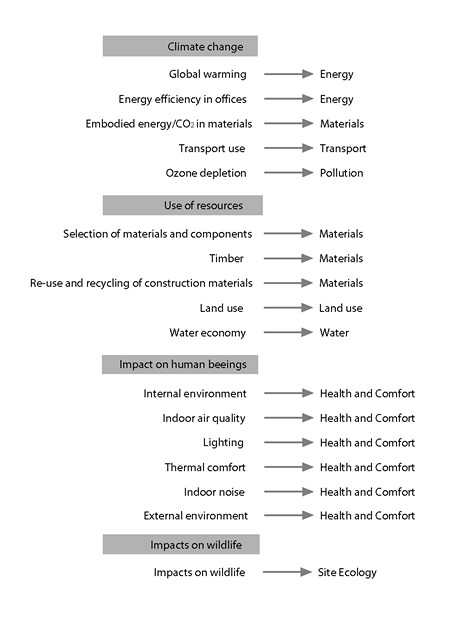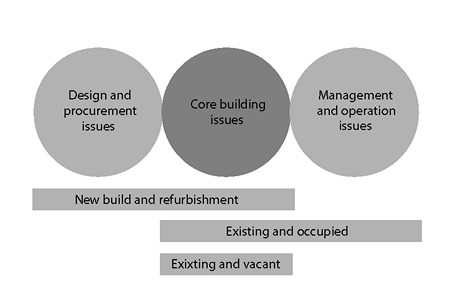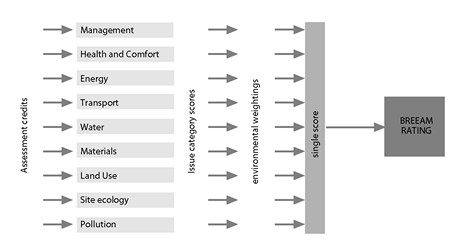Description
Office buildings are a noteworthy factor in the earth’s ecosystem. With the transition from an industrial society to a society of globally networked service providers, they have overtaken factories in energy consumption and pollution.
However, the developments in information technology that accompanied globalisation have also enabled a new understanding of the earth as a dynamic, non-linear system. The turning point for the notion of linear growth was marked by the Club of Rome’s 1972 report, “The Limits of Growth.” It took another twenty years, though, before the representatives of the world’s most important interest groups recognized the limits to industrial growth at the United Nations Conference for Environment and Development in Rio de Janeiro, and with Agenda 21, began to develop a strategy for dealing with the problems. It was then that the concept of ecological efficiency came into being.
The natural sciences, which were reaching their limits with the model of linear, causal systems, spurred today’s understanding that the earth is a complex system of different interdependent conditions that are extremely sensitive to each other and react dynamically to each other. With powerful computers, such complex systems can be analysed, understood and even put to use by means of data analysis.
For architecture, the consequence of this is that buildings have to be understood as integrative parts of the system in its entirety. Designing sustainable architecture today means not only conserving energy, but also placing the building in holistic relation to its environment. This takes place on the one hand via the façade and integrative building technology, in which IT plays an important role. It links together the supporting structure, the building technology and the building envelope into a coherent system. However on the other hand, ‘soft’ factors are taken into account, influences that make themselves felt through the building and have medium or long-term, local or global effects, such as the behaviour of the occupants with regard to transportation to the workplace, but also the avoidance of harmful substances in work processes. In this connection, knowledge of dynamic systems and their application as well as the evaluation of data with the aid of information technology play an important role.
In the following, two viewpoints from the debate on sustainability will be presented: the first, introduces a tool developed since 1992 for the evaluation and comparison of buildings and their influence on the environment, and the second, describes a more radical approach which accuses ecological efficiency of not dealing with the basics of environmental problems. With the concept of ecological efficiency, it suggests a far more fundamental solution.
The “Building Research Establishment Environmental Assessment Method” is the first widespread method for assessing buildings. It has in the meantime become an international organisation, even if mainly in the Commonwealth. BREEAM is supervised by the Building Research Establishment (BRE) and is implemented in cooperation with a network of licensed local representatives and assessors. The assessment is offered as a service that must be paid for, and the profits go to the parent organisation, the Foundation for the Built Environment, a private, non-profit organisation supported by a number of businesses, universities and civil-engineering organisations. In accordance with the “better buildings: better business” principle, BREEAM has created an assessment system for buildings that enables an unambiguous comparison of buildings by using clear criteria for defined sustainability. In so doing, new buildings and existing ones are set in relation to each other.

The problem zones assessed by BREEAM and their assignment to categories
The evaluation encompasses not only the construction of the building and its direct influence on the environment, for example, through material, transport, building site rubble and energy consumption, but also ‘soft’ factors like local public transport, building services and the occupants’ environmental protection programs. The goal is to make this evaluation into a standard of quality and thereby support sustainable building concepts in the property market.

The assessment of an office building comprises three parts. In all cases, a core assessment of the building fabric and services is undertaken, while the assessments of the other two areas – design/procurement and management/operating procedures – respectively take place during the design process or once the building is occupied
In order to arrive at a straightforward comparison (only four grades are given, Excellent, Very Good, Good and Pass), credits are given in the individual categories, which are then evaluated in the context of four problem zones (climate change, handling of resources, influence on human beings and influence on the animal and plant worlds). The interrelations between these four problem zones relative to the environment are determined by interviewing the most important interest groups, from politics, business, research and teaching to environmental protection organisations, and then taken into account in the evaluation.

Schematic representation of the assessment process up to the final, overall assessment under BREEAM
The concept of sustainability in use today is based on the three “R”s: reduce, reuse, recycle (of waste) and thereby on the reduction of damage caused to the ecosystem by man. Nature, however, doesn’t know the concept of waste; all substances are integrated in the cycle of nature.
The architect William McDonough and the chemist Michael Braungart pursue a radical approach that they call the “NEXT Industrial Revolution.” They set ecological efficiency in opposition to ecological effectiveness. The concept of ecological efficiency describes the current strategy of large enterprises, which consists in fulfilling ecological requirements in order to remain competitive. This means that they try to create added value in production and services with fewer raw materials and less pollution. Ecological efficiency requires a great deal of regulation; energy consumption, waste disposal techniques and the permissible levels of noxious emissions are all stipulated. Superficially, this strategy seems to be successful – noxious emissions have been reduced worldwide and in some industrial nations, buildings with sustainable concepts have even been built. According to McDonough and Braungart, however, the strategy is fundamentally inadequate, as it only controls and slows down the destruction of the ecosystem instead of avoiding it altogether.
By contrast, ecological effectiveness transposes the cycle of nature onto industry. The system of exhausting resources is transformed into a regenerative system; the cycle of industry, from “product to waste” becomes a “product-to-product” cycle. The concept of waste will disappear, because products will always be reusable, as in nature. For this reason, the first principle of the NEXT Industrial Revolution is “Waste equals food.”
All products have to be a basic component for a new product after the old one has lost its practical value. In order for this to be possible without impeding technical development, there should be two separate cycles, a biological metabolism and a technical metabolism. Products or clearly defined product components should contain either exclusively biological materials (nutrients) or exclusively technical materials, in order to keep these cycles separate from each other. Biological materials can be reintroduced into the cycle of nature, while technical materials should only circulate in the technical metabolism. Valuable technical building materials can retain their high quality only if product components that can be part of a closed industrial cycle are already defined in the design process. It would no longer be the products that are sold, but their use value. When a product’s use value is exhausted due to being outdated or worn out, the product would be exchanged for the next version. That way, the customer would only pay for the product’s service and not the material. A smooth transition from post-Fordism to eco-Fordism should therefore take place. The recognition that more money can be more consistently earned with knowledge and services combines with automation, standardisation and information technology to form the constitutive conditions for the NEXT Industrial Revolution. Without global networks and automated data management, such a model would be unthinkable.
The combination of economy and ecology is characteristic of both viewpoints, efficiency and effectiveness. They are based on the assumption that the incentive to change lies in the maximisation of profits and that environmental protection is dependent on it. Through ecology, and thus sustainable buildings, more money can be earned and at the same time, environmental conditions and conditions for man can be improved. While BREEAM has taken on a trailblazing role in the endeavours towards ecological efficiency with the goal of minimising damage, the NEXT Industrial Revolution attempts to reintegrate human activities in the ecologically effective system of nature with the goal of avoiding damage to the ecosystem entirely.
Originally published in: Rainer Hascher, Simone Jeska, Birgit Klauck, Office Buildings: A Design Manual, Birkhäuser, 2002.